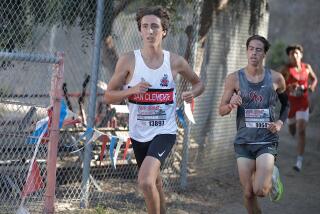Tour of California’s convoy of controlled chaos is the race behind the race
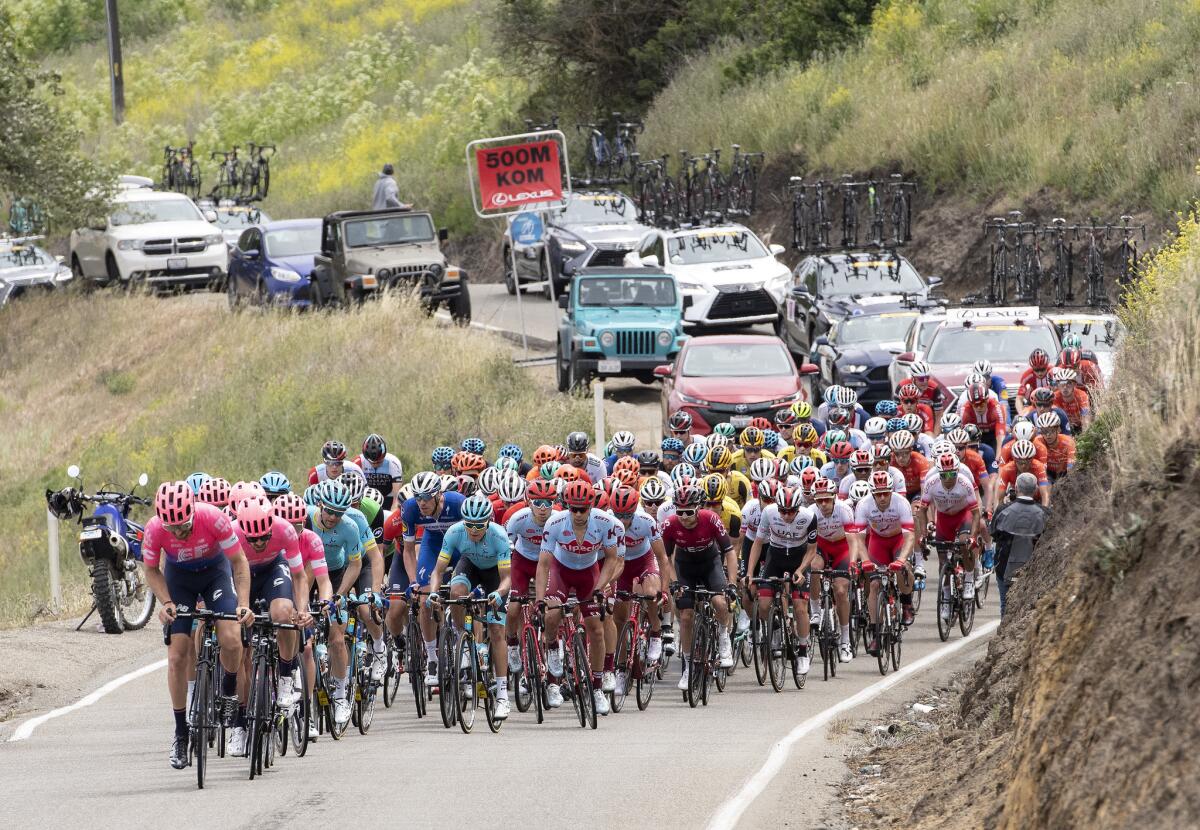
Halfway down the mountain, an acrid smell fills the car. Maybe the brakes are burning up, or the tires, as Tom Southam careens through a series of hairpin turns.
Other drivers traveling down this winding, two-lane road don’t faze him. He pulls to within a few feet of their rear bumper, then slides across the center line to pass.
“I could do this with my eyes closed,” he says.
The otherwise soft-spoken Englishman gets away with such hyper-aggressive behavior — a half-dozen moving violations in rapid succession — only because he is driving a team car in the Amgen Tour of California.
This is a part of professional cycling that fans don’t always see, the army of support vehicles that jostle along in chaotic, sometimes breakneck, fashion just behind the riders.
Cyclists need help during weeklong road races such as this one, which has traversed the state and will conclude in Pasadena on Saturday. Team cars carry food, water and extra parts. Each has replacement bikes on the roof and a mechanic in the crowded backseat ready to jump out for emergency repairs.
The man behind the wheel is more than a driver; he acts as coach, scanning video screens on the dashboard and listening to a cacophony of radios. He talks to his riders through their earpieces, feeding information on course conditions and wind, advising when to lay back and when to press ahead.
The process works smoothly enough on country lanes or slow climbs, but can turn hectic on steep descents where speeds jump to 50 mph.
As racers fly down the mountainside, team cars jockey for position just behind them, screeching around turns, passing each other in the tightest of spaces.
“When you see the convoy for the first time, you wonder,” Southam says. “How does this possibly work?”
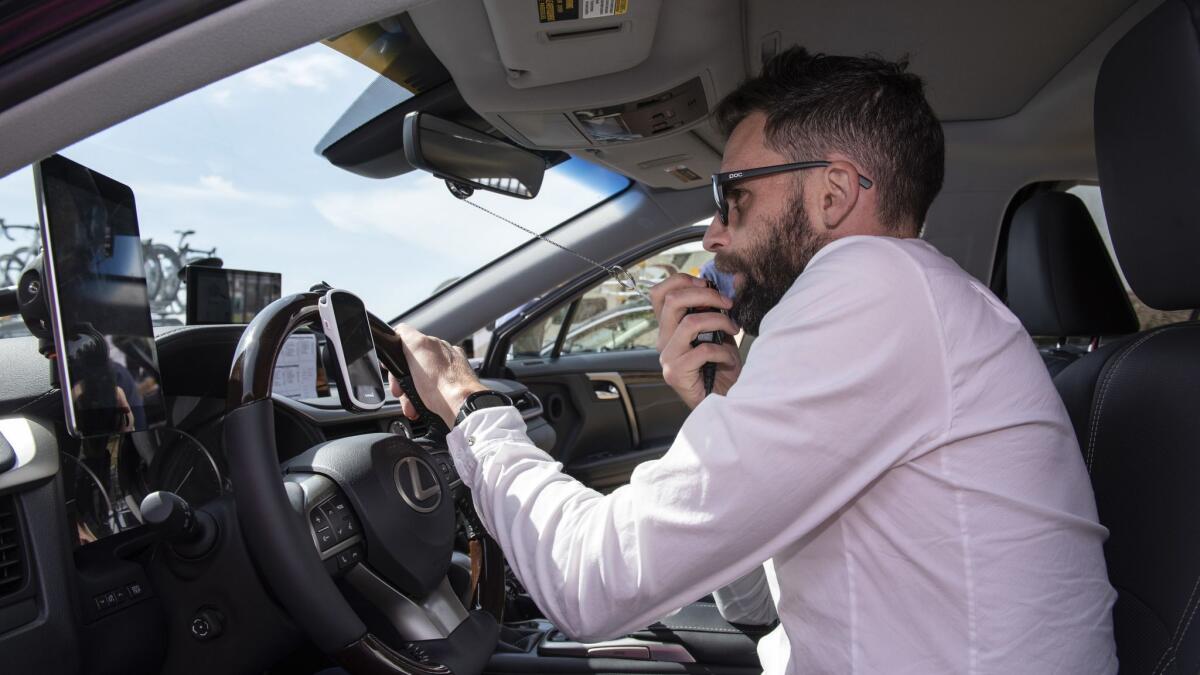
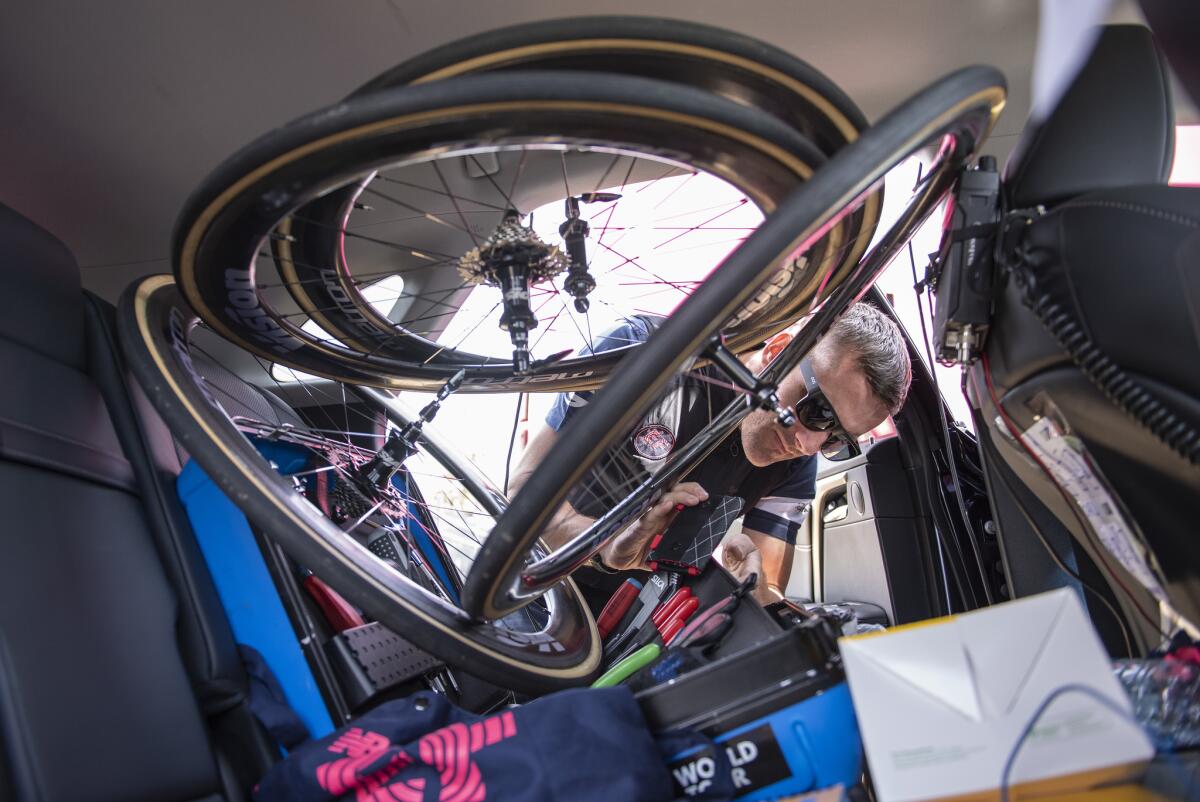
Leading the pack
Tuesday morning dawns clear and warm as the Tour of California’s third stage embarks from Stockton, 19 teams with a total of 132 riders heading southwest through farmlands of brown and dusty green.
A field worker sits on his tractor, peering from beneath a straw hat as the peloton — the main pack — buzzes past like a swarm of insects.
The seven riders on the EF Education First Pro Cycling squad are feeling confident because their top man, Tejay van Garderen, holds the overall lead. His yellow jersey status means that team director Southam gets to drive at the head of the convoy, or caravan, just behind race officials in their SUV’s and motorcycles.
His position has two advantages: Riders can drop back for food or equipment more quickly, and Southam gets a clearer view of the action ahead. But a few minutes into the 130-mile stage, something goes wrong.
Grabbing a microphone that dangles from the rearview mirror, Southam calls — once, twice, three times — for Van Garderen and gets no reply. “Not a good time for radio problems,” he mutters. “We need to get this sorted out.”
The other EF Education First riders pass along a message and Van Garderen drifts back, positioning himself next to the driver’s side window of Southam’s sleek black car. Still pedaling, he takes out his earpiece and tries another. When that doesn’t work, he reaches inside his jersey and rips out a small black receiver.
Southam steers with one hand while exchanging parts with the other, his gaze shifting continually. Sometimes, he must reach with both hands and steer with his knees.
It takes a few minutes of trial and error before mechanic Tom Hopper, wedged into the backseat amid coolers, bags and extra wheels, devises a fix that allows Van Garderen to rejoin the peloton.
“Some of this stuff you can’t prepare for,” Hopper says. “You just have to be ready for anything.”
Radio glitches can be annoying; other problems require more-urgent response. In racing terms, they are known as “mechanicals.”
Such a mishap hits EF Education First a little later when Rigoberto Uran goes down in a crash that knocks his handlebars off kilter. Southam swerves onto the dirt shoulder and slams on the brakes, skidding to a stop.
“Go, go, go!” he yells to Hopper.
The mechanic hops out and pulls another bike off the roof rack so Uran can resume racing. It would be best to grab a wrench and straighten the damaged handlebars, in case Uran needs to switch again.
Southam checks the map and says: “There isn’t time.”
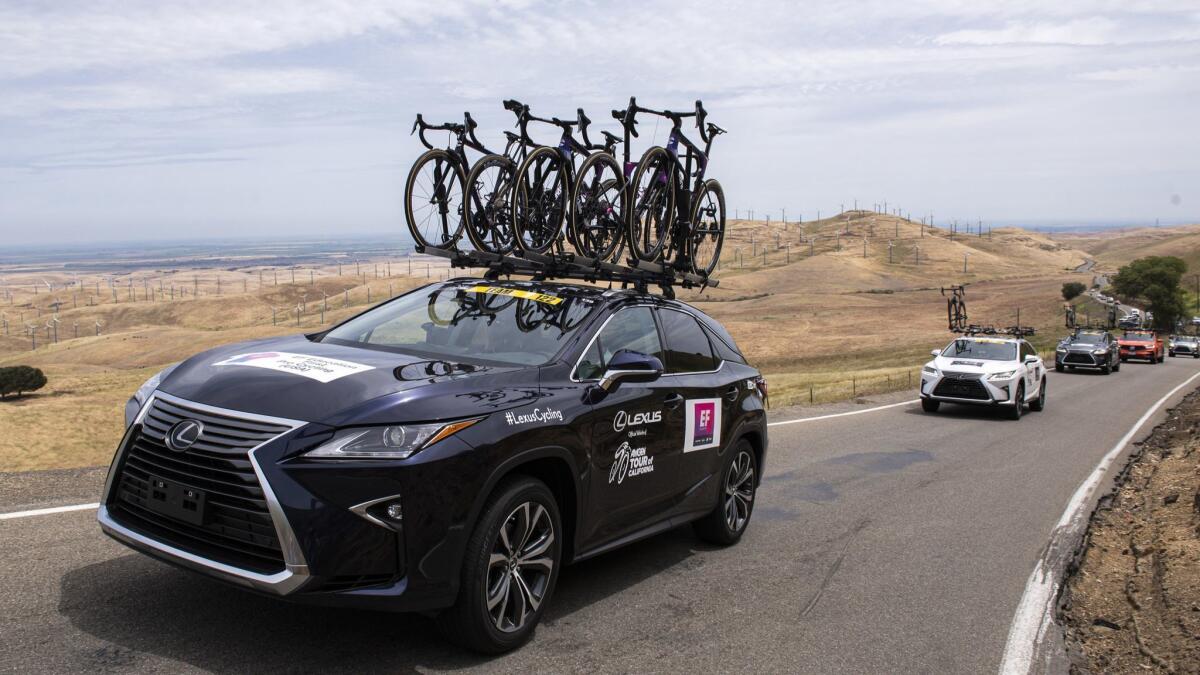
A war room on wheels
Each team car is given a position at the start of each stage, determined by the overall standings, but the caravan’s order shifts constantly once the race begins.
If a rider needs water or a repair, an announcement goes over the official radio and his crew is allowed to speed to the front. Southam lets those rivals pass, then waits eagerly for them to finish so he can weave his way back to the coveted No. 1 spot.
A former professional cyclist, the 37-year-old maintains a slim build, his narrow face framed by a scruff of beard. Taking a team director’s job after his competitive days ended, he learned bits of Italian, Spanish and French to communicate with an ever-changing roster.
“I quite enjoy the races,” he says. “I enjoy working out how to get the best out of riders.”
His manner over the radio is unruffled and he often seems lost in calculation, leaning forward at the wheel, straining to see his pink-jerseyed team. Observation is key because the team car can be like a war room, a place for strategizing on the fly.
An hour or so outside of Stockton, two riders — from different teams — sprint from the pack, pulling out of sight. Southam must quickly assess the situation.
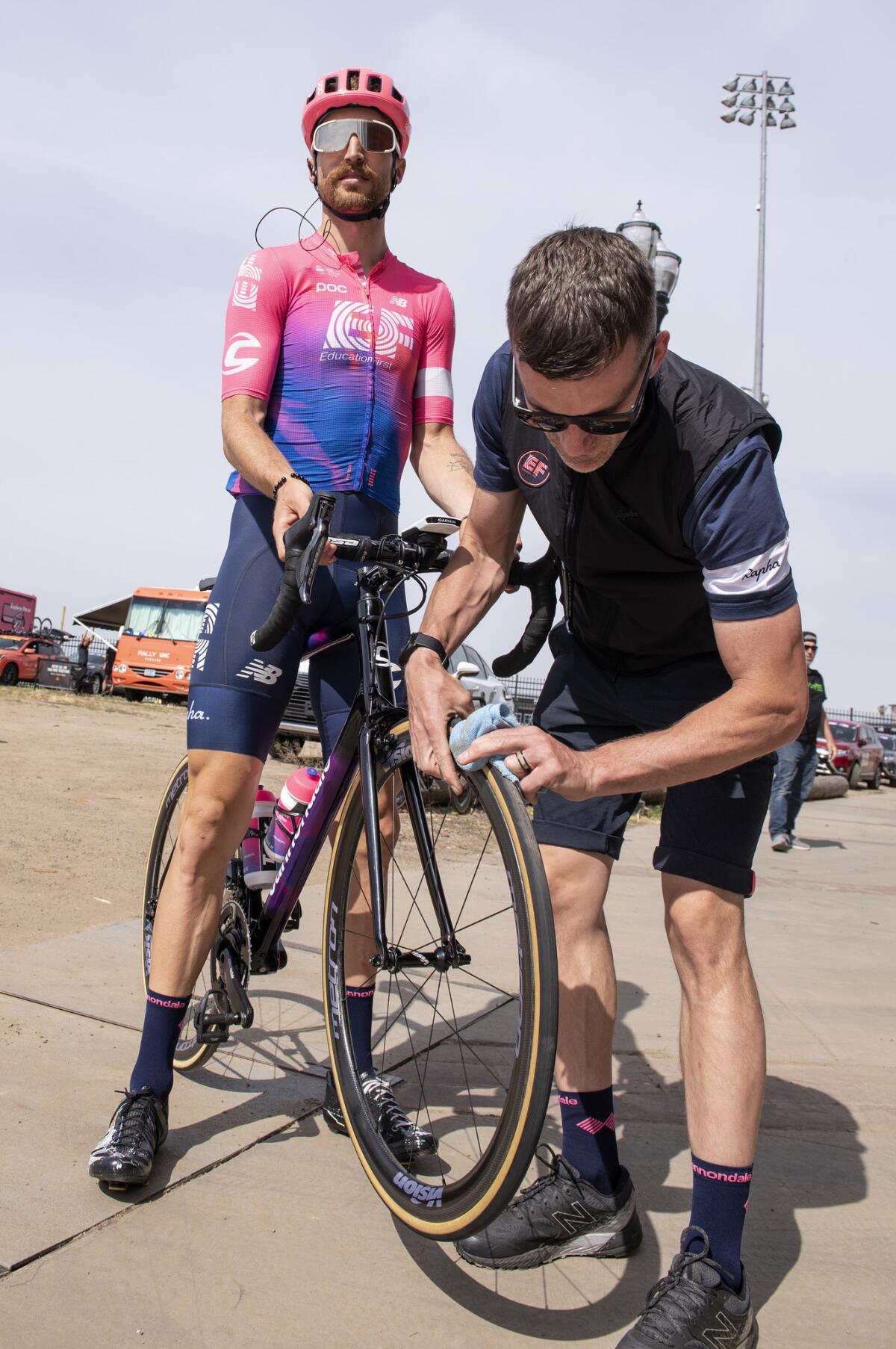
Who are the breakaway riders and are they strong enough to maintain the lead for hours to come? If so, are they placed high enough in the standings to threaten Van Garderen’s yellow jersey by day’s end?
Soon, the EF Education First riders call over the radio with anxious questions, wondering if they should give chase.
“They’ve got all this cortisol rushing around their brains,” Southam says. “It’s not easy to think.”
The director has the advantage of overview, listening to the race announcer, glancing at maps and thinking ahead to a grueling mountain ascent that could decide the stage. Because his riders excel at climbing, he tells them to conserve their energy.
“We can’t see five miles up the road,” Van Garderen says. “We need someone who knows the sport of bike racing and gives us the correct information.”
But Southam cannot access the vibe on the course or the strength his team holds in reserve.
An hour or so later, when the breakaway widens to 10 minutes, he asks his guys to pick up the pace before the climb. They sound hesitant.
“Hey Tom, practical mastermind,” rider Taylor Phinney says. “What’s the reason?”
Southam isn’t the only one making decisions. EF Education First has a second car, farther back in the caravan, driven by another director and former racing teammate, Charly Wegelius. They deliberate over a separate radio channel.
“You can get the tactics wrong,” Southam says. “You can say the wrong thing to the riders … that’s obviously a bad one.”
The directors agree it won’t do any good to push the team too hard, leaving everyone spent for later in the stage and, perhaps, days to come.
“Everyone thinks the [directors] have the whole race in their hands, but it’s really a back-and-forth relationship,” rider Alex Howes says. “It’s not PlayStation … you can’t just turn us on.”
A dizzying descent
There are moments of boredom, cruising through the foothills at uniform speed. Wegelius chatters over the radio, joking about cows, trees and old Kevin Costner movies.
Finally, after four hours of riding, the road gently rises through groves of ponderosa pine, then turns suddenly steep in switchbacks. The ascent of 4,265-foot Mt. Hamilton has begun.
The breakaway riders still have a big lead but EF Education First continues to head the peloton as rivals drop back in exhaustion. Now Southam shifts to cheerleader.
“Very good, guys,” he tells his team. “You’re the strongest in this race.”
At the mountaintop, where the domes of Lick Observatory rise above the treetops, he warns that other teams might try for a breakaway. Also, his riders need to take care.
“This is really dangerous,” he tells them. “So let’s be on it here.”
The road drops precipitously in a succession of sharp turns with pavement often pitted and cracked. The cycling term — “technical descent” — fails to describe a ride that can be harrowing on two wheels and almost as frightening in a car.
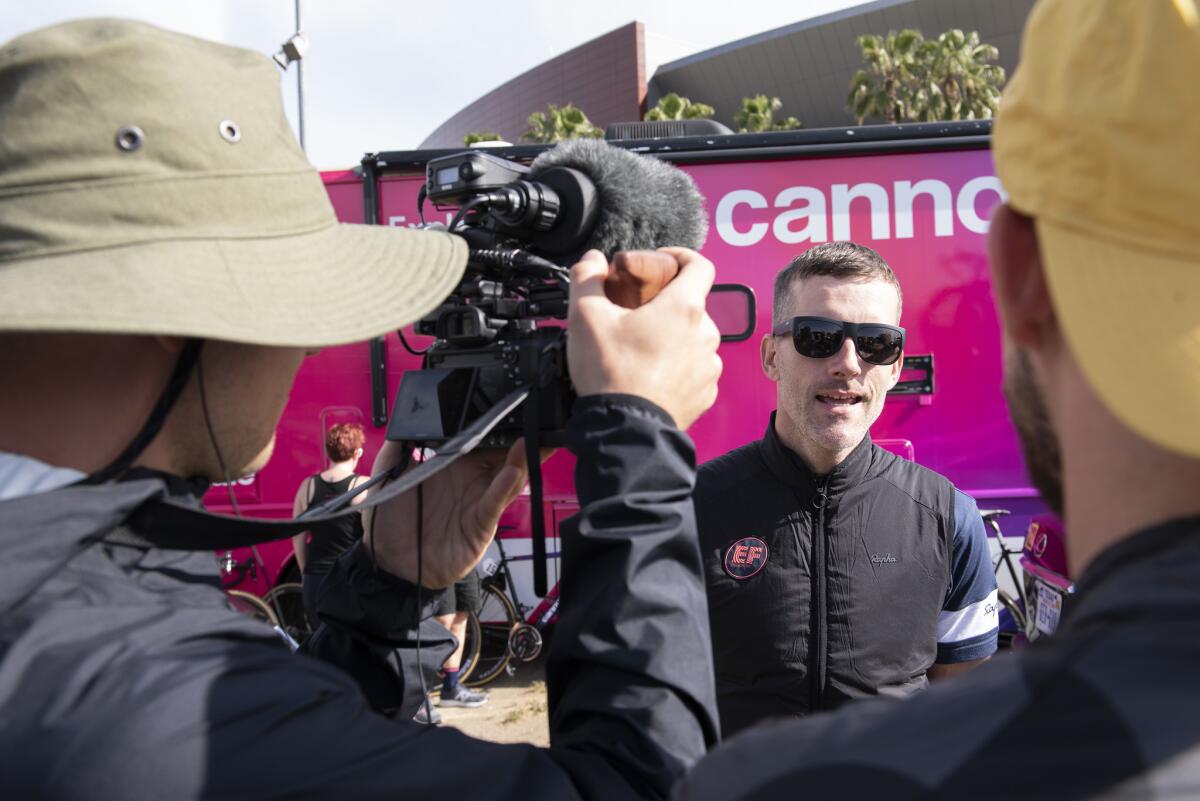
Both hands on the wheel, Southam leans into each curve as his tires squeal in protest. Rival crews had moved ahead to service their riders at the peak and now he wants his spot back, squeezing around cars and between motorcycles at blurry speed.
The downhill ride is violent enough that a reporter in the passenger seat — and even Hopper in the back — feel slightly dizzy by the time the course levels for the final stretch. Leaving the forest behind, the road widens and continues past housing tracts and storefronts, leading toward the finish line in a bedroom community south of San Jose.
A young Frenchman named Remi Cavagna has turned his breakaway into a convincing stage victory. Back in the peloton, Education First works to protect Van Garderen’s overall lead as Southam worries about a last-second gaffe.
“There are so many things that can go wrong,” he says.
Not this time. EF Education First holds its place and Van Garderen, all smiles, keeps the yellow jersey with a six-second advantage. Though the afternoon has darkened, clouds filling the sky, the mood is upbeat.
Sign up for our daily sports newsletter »
Riders aren’t the only ones who deserve credit after a long, hard stage. Van Garderen said earlier: “It’s always the sign of a good director. No matter how hectic things get, they have a way of keeping calm.”
But Southam has no time to celebrate as fans converge on the team’s massive, pink-and-purple motor home. A 133-mile stage will begin down by Salinas the next morning.
“Every race, something different happens,” he says.
There are only 17 hours to review the third stage — good and bad — devise a game plan and get a little sleep. Southam hops in his car and drives off.
Follow @LAtimesWharton on Twitter
More to Read
Go beyond the scoreboard
Get the latest on L.A.'s teams in the daily Sports Report newsletter.
You may occasionally receive promotional content from the Los Angeles Times.



